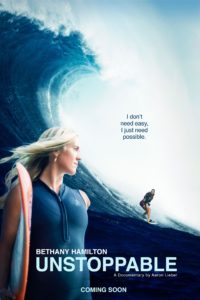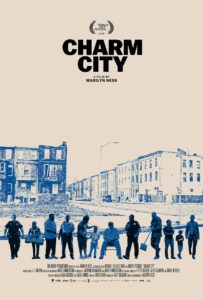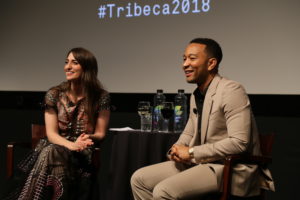TRIBECA 2018, Part 2: The Multi-Varied Multivalent Mediaverse of Today
Written by: Christopher Llewellyn Reed | April 27th, 2018

I was only able to attend the first three days of the 2018 Tribeca Film Festival (TFF), but (with the help of a few screeners sent to me for home viewing) I still managed to watch 10 feature-length films, 1 forty-minute documentary short, and 1 episodic premiere, as well as attend one live “Tribeca Storytellers” presentation and spend time in the VR area (for my thoughts on those latter projects, see Part 1 of my Tribeca 2018 coverage). Though not all film-and-moving-image works are created equal, I mostly enjoyed what I saw. Contrary to some other film festivals I regularly attend (AFI DOCS, Annapolis, Maryland, Middleburg and SXSW, for example), Tribeca holds separate “press and industry” screenings of media both before the festival begins (only useful if one lives in New York) and from 9am to 5pm during the actual festival, thereby facilitating access to content for critics while prioritizing admission to regular events for pass- and ticket-holders. While I initially had some mixed feelings about this segregation, I can’t argue with the ease of entry it created for people like me, while no doubt opening up a few more seats at the normal screenings for paying customers. I nevertheless attended some non-press-specific evening events, which crackled with the usual energy that festival audiences always bring.

I love Manhattan, having lived there from 1997 to 2006, and miss it daily, though I also have great affection for my current hometown of Baltimore, where I spent my formative teenage years and where I have lived again ever since my move from New York (stay tuned for my upcoming coverage of the Maryland Film Festival!). This year, the TFF venues ranged from the Festival Hub at 50 Varick St. (in actual Tribeca), just south of Canal St., to even deeper south and west on the island, and all the way up to Chelsea, at 23rd and 8th. It’s a gentle commute between locations by subway, or even on foot if one has time and a desire to stretch one legs a bit. Beyond the great setting, the TFF offers a terrific variety of films and “episodics” (as television series are now called). What follows, below, are capsule reviews of my Top 5½ (sneaking in that short) – all of which are documentaries (for whatever reason, I have often, though not always, appreciated the nonfiction programming at festivals more than the fiction films, even before I was part of a documentary-themed podcast) – in alphabetical order, with a few sentences on each of the rest.

Bethany Hamilton: Unstoppable (Aaron Lieber, 2018)
Whether or not one knows, ahead of time, the story of one-armed surfer Bethany Hamilton, director Aaron Lieber’s documentary portrait of her, Bethany Hamilton: Unstoppable, should inspire all who watch with its narrative of survival, triumph and, above all, perseverance. In 2003, at 13, a rising star of the waves, Hamilton was attacked by a large tiger shark that bit off her left arm. Born and raised in Hawaii and primed from birth for a career in surfing, Hamilton was understandably depressed for a number of reasons, but after 4 weeks, somehow, was back on a board, and two years later became the improbable women’s champion at the 2005 National Scholastic Surfing Association (NSSA) competition. Since then, though victories have been harder to come by, Hamilton has found joys in other ways, as well, including marriage, motherhood and her deep faith in God. Using archival material and beautifully photographed new footage, Lieber (making his directorial debut) presents Hamilton in all her guts and glory, as she surfs while nursing a newborn between rides – a maternal muse to her fellow competitors, and women around the world – trains through the pain, and practices her moves on the daunting wave known as “Jaws” (traditional name Pe’ahi), off the coast of Maui. Though occasionally devolving into promo territory (the sometimes-bombastic score doesn’t help), the film is engaging throughout. Trophies or no trophies, Bethany’s a winner.

Charm City (Marilyn Ness, 2018)
There has been no shortage of documentary films, of late, about either violent urban landscapes or, even more specifically, Baltimore City (again, my hometown), one such hard-hit metropolis. Many of them focus on the fraught interactions between local residents and the police, the former – often justifiably – seeing the latter as a relentless oppressor. Some deal with that issue as the main focus of the story, while others treat it as omnipresent background. Just in the last year, we’ve seen such movies as The Force (about Oakland) and Quest (about Philadelphia), and then Baltimore Rising, Rat Film and, the most buoyant of the bunch, Step, all set here in Charm City (our fair town’s nickname). This brings us to director Marilyn Ness’s latest work, which borrows the phrase – a legacy of a 1970s slogan campaign, these days frequently spoken with irony – for its title, and plunges us, yet again, into the quagmire of failed civic policies. Here, we find ourselves in the Rose Street neighborhood of Southeast Baltimore, where the inhabitants, suffering from a 50% unemployment rate, struggle to make ends meet and to keep their streets clean and safe. Embedded with community members and police officers, Ness (Bad Blood: A Cautionary Tale) and her crew offer up compellingly competing points of view – not always in complete opposition – to create a vibrant tapestry where hope and despair collide, the one never quite succumbing to the other, their battle always gripping.

Island of the Hungry Ghosts (Gabrielle Brady, 2018) – Winner of Tribeca’s Best Documentary Feature Jury Award
Shooting on Christmas Island, an Australian possession in the Indian Ocean, south of Indonesia, director Gabrielle Brady (making her feature debut) has created a mesmerizing, elliptical work of cinematic wonder, filled with breathtaking images, the whole an evocative setting for a vital discussion of human rights. Red crabs climb over volcanic rock, migrating across the island, protected by patient conservation workers who help them navigate the roads that didn’t exist even 100 years ago (human beings are but a recent import). At the same time, trauma counselor Poh Lin struggles to assist refugees from the nearby top-secret detention center, while also raising two bilingual children with her French husband, both model parents who love to hike and camp as a family. Unfortunately, government bureaucracy, coupled with a deep insensitivity and profound inhumanity towards the detainees, prevents Poh Lin from doing her job as she would like, and the intermittent sessions she is able to organize leave her depleted and depressed. Meanwhile, the crabs continue their own migration, their careful treatment by official forces a stark contrast to the callous handling of the refugees. An adaptation of a short film that Brady made for The Guardian newspaper, Island of the Hungry Ghosts (the title refers to the Chinese immigrant population’s belief that the island’s first human inhabitants, improperly buried, left behind unsettled spirits) announces a great new cinematic talent from whom we should all hope to see more in the future.

Ryuichi Sakamoto: Coda (Stephen Nomura Schible, 2017)
Though all-too-imperfectly shot (a source of both its charms and its flaws), filled with too many jittery, off-kilter close-ups for my taste, Ryuichi Sakamoto: Coda – the debut theatrical feature of director Stephen Nomura Schible – has one major thing going for it, and that is the quiet charisma of its titular subject. Born in 1952, Japanese composer Sakamoto has a career that spans many different musical eras and styles. Deeply invested in environmental causes, he first appears on screen visiting Fukushima, site of a 2011 nuclear disaster. After that, we jump forward to his diagnosis of Stage 3 throat cancer (for which he later undergoes treatment), and then jump back and forth between the present and the various highlights of his life and work. As much a pop artist as serious classical musician, Sakamoto has also written many film scores, including Merry Christmas Mr. Lawrence (in which he also starred as the camp commander), The Last Emperor, The Sheltering Sky and The Revenant, the latter of which proves quite the struggle because of cancer-caused fatigue. He also expresses a deep admiration for the works of Bach, as well of the films of Soviet filmmaker Andrei Tarkovsky, and how that director uses Bach in his movies (we return, time and again, to images and sounds from his Solaris). In short, he is a man of wide-ranging interests and accomplishments, still possessed of an active imagination and not quite willing to go gently into that good night. Coda? How about an encore …

When Lambs Become Lions (Jon Kasbe, 2018) – Winner of Tribeca’s Best Editing in a Documentary Film Jury Award
“Better to kill the poacher and save the elephant,” says one character – a park ranger in Kenya – as he considers the difficulties faced by him and his colleagues in their struggle to preserve one of their country’s great national treasures, the endangered African elephant. What makes When Lambs Become Lions especially interesting is that the same ranger who utters this line will later switch sides, helping a poacher with a tip on where to find prey. The cost of ivory is high on the international black market, and a ranger’s salary is low, or even nonexistent; we watch as the bosses make excuses for the lack of funds. What is a husband and father to do, if he wants to feed his family? Director Jon Kasbe, whose first feature this is, presents the facts of the case, showing why ostensibly good people might do very bad things. Fortunately, he avoids a display of slaughter, choosing to focus on the machinations of the competing constituencies, instead. We see plenty of ivory, but no elephants being killed. Gorgeously photographed (especially the nighttime scenes) and yes, perfectly edited, the film is a testament to the power of good investigative journalism and embedded filmmaking.
And then there was the short documentary …

The Girl and the Picture (Vanessa Roth, 2018)
At just 40 minutes, The Girl and the Picture, from director Vanessa Roth (The Texas Promise), can hardly be accused of overstaying its welcome. The devastating, yet riveting, tale of 88-year-old Xia Shuqin, a survivor of the infamous 1937 Nanjing Massacre, in which Japanese troops killed hundreds of thousands of civilians in an act of genocidal terror, the film cuts between the present day, where Xia’s granddaughter records the story, in writing, for her own child, and the grisly past, seen through archival films and photos. Roth elevates her story beyond the purely journalistic by bringing in the additional thread of the Reverend John Magee, an American Episcopal missionary who documented the atrocities, in still and moving images (later used as evidence in war-crimes trials against the Japanese commanding officers), all the while administering an International Safety Zone that managed to save thousands from certain death. One of his subjects was the then 8-year-old Xia Shuqin. Now, Magee’s own grandson, Chris, comes to China to pay his respects and hold his grandfather’s precious Bell & Howell windup camera. Together, the survivor and the descendant a profound narrative do make.
And that’s it for my Top 5½! Now here are my very brief thoughts on all the rest, starting with the Season 2 premiere of Westworld and then moving on to fiction films, in alphabetical order.
Westworld, Season 2 Premiere: “Journey into Night” (Richard J. Lewis, Director; Lisa Joy and Jonathan Nolan, Creators)
I loved Season 1, and the trailer for Season 2 promises more great things. This particular episode, however, though possessing some good moments, disappoints in its plotting. We pick up after the massacre that ended the Season 1 finale, and jump back and forth between the various characters in two separate timelines (something I also liked). As with many episodics, however, watching just one part of a longer story, built for the long game, is never satisfying. Catch me again once I’ve seen it all.
Cargo (Ben Howling/Yolanda Ramke, 2017)
Based on a previous short film by the same team, Cargo follows actor Martin Freeman (Whiskey Tango Foxtrot) as he struggles to keep his daughter alive during a zombie apocalypse in Australia. It starts out well, but by the end devolves somewhat into inchoate, bloody mayhem, complete with typical white-person mystical views of Aborigines. Thanks to its star, it still remains mildly entertaining even through to the end.
The Dark (Justin P. Lange, 2018)
An off-beat undead movie that recalls the Scandinavian Let the Right One In, without ever achieving anything close to its sublime greatness, The Dark offers some solid horror pleasures and engaging characters. Lead actress Nadia Alexander (Nadine on Netflix’s Seven Seconds) is compelling a young girl done wrong by her mother’s boyfriend, rising from the grave as a vengeful, flesh-eating monster, who discovers the meaning of love and friendship when she meets an equally abused child. Though the pacing, mood and performances are inconsistent, there is still a lot to recommend.
Disobedience (Sebastián Lelio, 2017)
Sebastián Lelio’s follow-up to his Oscar-winning A Fantastic Woman, Disobedience is also the director’s first English-language film. Starring Rachel Weisz (My Cousin Rachel), Rachel McAdams (About Time) and Alessandro Nivola (The Wizard of Lies) as three sides of a love triangle set in an Orthodox Jewish community in London, the movie features strong acting and a powerful message of female empowerment, as well as one of the most graphically sensual (as opposed to sexual) love scenes I have scene, recently (a lot of licking, rubbing and spitting into the mouth). Though at times strangely inert, it succeeds often enough in its hothouse ambitions to be mostly worth watching.
Mary Shelley (Haifaa Al-Mansour, 2017)
Inert? Try flaccid. As a fan of Mary Shelley’s 1818 masterpiece Frankenstein, I very much wanted to like this movie, and was bitterly disappointed that I did not. Though Elle Fanning (The Neon Demon) engages as the titular character, the meandering script and irritating supporting characters lend the affair a dispiriting twist that no amount of final cathartic publishing success can rectify.
You Shall Not Sleep (“No dormirás“) (Gustavo Hernández, 2018)
Brilliantly atmospheric, if utterly ridiculous in a narrative sense, the Spanish-language You Shall Not Sleep is a glossy and beautiful artifact that might appeal to aficionados of ghost stories and horror, but not to anyone looking for coherence. Character motivations remain unclear throughout, the plot hinging on the lead’s choice to undergo sleep deprivation as performance art, but the whole is staged in a gorgeous location and framed in considered and well-lit compositions. It’s nice to look at, from afar.

Beyond the screenings, I had a wonderful time watching actress/singer/songwriter Sara Bareilles (The Broadway musical Waitress) lead a discussion between her and actor/singer/songwriter John Legend, as part of the “Tribeca Talks” series.
And that’s it for my Tribeca coverage. See you next year!


